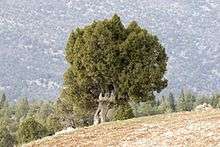Juniperus indica
Juniperus indica, the black juniper, is a juniper native to high-altitude climates in the Himalaya, occurring from the northern Indus Valley in Kashmir east to western Yunnan in China.
| Juniperus indica | |
|---|---|
 | |
| Scientific classification | |
| Kingdom: | Plantae |
| Clade: | Tracheophytes |
| Division: | Pinophyta |
| Class: | Pinopsida |
| Order: | Pinales |
| Family: | Cupressaceae |
| Genus: | Juniperus |
| Section: | Juniperus sect. Sabina |
| Species: | J. indica |
| Binomial name | |
| Juniperus indica Bertol. | |
| Synonyms[2] | |
| |
It is of interest as the highest elevation woody plant known, reported growing as high as 5200 m in southern Tibet; the lowest limit being 2600 m.
It is a shrub growing to 50–200 cm tall, with largely horizontal branching. The leaves are dark grey-green, dimorphic, with adult plants having mostly scale-like leaves 1–3 mm long, while young plants have mostly needle-like leaves 5–8 mm long, but needle-like leaves can also be found on shaded shoots of adult plants. The leaves are borne in whorls of three on strong stout main stem shoots, and opposite pairs on thinner, slower-growing shoots. It is dioecious, with male (pollen) and female (seed) cones on separate plants. The mature seed cones are ovoid, berry-like, 6–10 mm long, glossy black, and contain a single seed; the seeds are dispersed by birds which eat the cones, digest the fleshy cone pulp, and excrete the seeds in their droppings.
References
- Farjon, A. (2013). "Juniperus indica". IUCN Red List of Threatened Species. 2013: e.T42238A2965473. doi:10.2305/IUCN.UK.2013-1.RLTS.T42238A2965473.en.
- The Plant List: A Working List of All Plant Species, retrieved 5 March 2017
- Conifer Specialist Group (1998). "Juniperus indica". IUCN Red List of Threatened Species. 1998. Retrieved 12 May 2006.CS1 maint: ref=harv (link)
